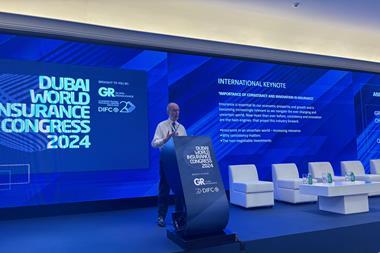In a world so hard to plan for, we must be able to react decisively to whatever comes next. International programmes can offer clarity and consistency, says HDI’s Antonia Osborne, helping businesses stay agile and respond quickly when trouble strikes.

In today’s volatile business environment, risk managers and CROs are under mounting pressure to protect global operations from an expanding array of threats. From shifting political regimes and trade restrictions to supply chain instability and currency controls, the risks facing international businesses are more complex – and more interconnected – than ever before.
“Every country around the world is now in a reactive space going: what’s going to happen next?” says Antonia Osborne, director of underwriting at HDI Global SE, UK and Ireland. “Because how can you plan when you’re operating with so much uncertainty?”

She adds that as political and economic pressures intensify, many companies are no longer equipped to manage every risk and regulatory hurdle internally. That’s where international insurance programmes come into their own – not only simplifying global risk transfer, but also helping organisations remain agile and operational when unexpected shocks occur.
Clarity across borders
One of the clearest benefits of an international programme is simplification. With consistent terms and a single point of reference, multinational risk managers can reduce confusion and ensure global alignment.
In practice, risk managers are often managing dozens of insurance arrangements across different jurisdictions, languages, and legal environments. This complexity leads to inconsistencies, sometimes in the most critical areas of coverage, and exposes businesses to the danger of unintentional gaps.
“A good international programme is all about giving clarity to the client,” says Osborne. “If you’re a risk manager operating across 40 or 50 territories, having one master contract that clearly outlines what is and isn’t covered is absolutely vital.”
A well-executed international programme not only creates visibility for head office risk teams, it builds consistency for local operations, making internal governance easier and ensuring group-wide risk posture is aligned.
Clarity is a prerequisite, but resilience also requires responsiveness. In the current climate, where geopolitical and economic shifts can trigger near-instant upheaval, speed matters just as much as structure.
For example, capital controls, sanctions or import restrictions can upend local operations overnight. Without rapid intervention, these disruptions can stall claims payments, leave gaps in regulatory compliance, or even void cover altogether.
Osborne illustrated this with Argentina’s sudden introduction of a currency tax, which threatened to leave clients without accessible coverage. “We were able to put something in place there very, very quickly… If a client had to figure that out themselves, hire lawyers, find a workaround, it would be expensive, slow, and stressful.”
International programmes, by design, allow insurers to act swiftly because they already have a pre-negotiated framework and central coordination. This can mean the difference between a proactive solution and a prolonged operational crisis.
Real-world help when things go wrong
While the value of a global insurance programme is often measured at the point of claim, its strategic importance lies in business continuity. And in a time of strained supply chains and stretched workforces, practical support from insurers is more critical than ever.
Osborne shared an example where HDI used its international network to locate a rare manufacturing part after a client’s critical equipment failed. “We tapped into our network… and found a supplier,” she says. “That’s where international programmes become more than insurance – they become part of a company’s resilience plan.”
This kind of support reflects a broader shift in insurer–client relationships: from transactional risk transfer to strategic partnership. In complex environments, clients value not just indemnity but insight, logistics and collaboration. International programmes, when built on strong networks, unlock this value at scale.
As governments around the world become more protective and prescriptive in their regulatory approaches, compliance risk has emerged as a top concern for global insurance buyers.
“That’s where international programmes become more than insurance – they become part of a company’s resilience plan.”
Inconsistent rules around licensing, claims payments, taxes and documentation can make it extremely difficult for risk managers to ensure their insurance structure is legally valid everywhere it operates. A misstep, however unintentional, can result in claims being denied or even regulatory fines.
“There are so many nuances,” Osborne says. “Some countries require premium to be paid before cover incepts. We educate clients, not just on the policy terms, but on the wider implications.”
International programmes help centralise oversight and reduce this exposure. But success relies on close collaboration with insurers who understand the local landscape, and can update clients when rules shift. Without that embedded expertise, even well-designed programmes can fall short under regulatory scrutiny.
How to get it right
International programmes aren’t one-size-fits-all. They demand thoughtful planning, internal collaboration, and ongoing review to ensure they match how the business operates, not just how the insurance market is structured.
One of the most common mistakes is treating programme design as a procurement exercise. Osborne warns that relying on generic advice or limited brokerage capabilities can leave businesses with an expensive structure that doesn’t meet their needs.
“You can’t go to a small local broker and say: ‘Help me put together an international programme.’ That may not be their area of expertise,” she says. “You need partners that understand the full picture – how to structure the programme, how to allocate premium, how to move claims funds, how to keep everything compliant.”
“An international programme isn’t just an insurance structure, it’s a strategic tool for helping global businesses stay agile”
Successful programmes are typically built on a foundation of internal engagement, where global and local teams are aligned around shared priorities. Ongoing dialogue, both within the business and with insurer partners, is key to adapting to evolving needs, regulations, and exposures.
In a world where uncertainty is the only constant, international programmes provide risk managers with a structure they can rely on. But to succeed, these programmes must be built on clarity, responsiveness, real-world experience, and trust.
As Osborne sums it up: “An international programme isn’t just an insurance structure, it’s a strategic tool for helping global businesses stay agile, compliant and supported when the unexpected hits.”













